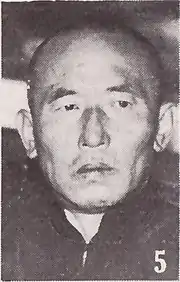
Yu Pinqing (simplified Chinese: 于品卿; traditional Chinese: 於品卿; pinyin: Yú Pǐnqīng; Wade–Giles: Yü P'in-ch'ing) (1886 – December 24, 1945) was a politician and industrialist in the Republic of China. He was Supreme Member of the Southern Chahar Autonomous Government (察南自治政府; Chánán Zìzhì Zhèngfǔ), later he was also appointed Vice-Chairman of the Mongolian United Autonomous Government (蒙古联合自治政府; 蒙古聯合自治政府; Ménggǔ liánhé zìzhì zhèngfǔ) and the Mongolian Autonomous Federation (蒙古自治邦; Ménggǔ zìzhì bāng). He was born in Nangong, Zhili (Hebei).
Biography
Yu Pinqing was an industrialist in Zhangjiakou. In 1924 he became an executive member of the chamber of commerce in Zhangjiakou.[1][2]
In August 1937 Japanese Army occupied Zhangjiakou. Yu Pinqing was invited by Japanese, and he was appointed a member of the Peace Preservation Council in Chahar. In next month, Southern Chahar Autonomous Government was established, he was appointed Supreme Member of it. In November, the Mongolian United League Autonomous Government (蒙古联盟自治政府; 蒙古聯盟自治政府; Ménggǔ liánméng zìzhì zhèngfǔ), the Southern Chahar Autonomous Government and the Northern Shanxi Autonomous Government (晋北自治政府; 晉北自治政府; Jìn běi zìzhì zhèngfǔ) held a representative assembly at Zhangjiakou. Then the Mengjiang United Committee (蒙疆联合委员会; 蒙疆聯合委員會; Méng jiāng liánhé wěiyuánhuì) was established, Yu was appointed a member of it.[1][2]
In September 1939 three autonomous governments merged into the Mongolian United Autonomous Government, Yu Pinqing was appointed Vice-Chairman of it. In 1941 Mongolian United Autonomous Government was renamed and reformed to the Mongolian Autonomous Federation, while he also stayed on Vice-Chairman of it.[1][2]
In August 1945 Mongolian Autonomous Federation had collapsed, then the Eighth Route Army occupied Zhangjiakou, and Yu Pinqing was arrested by it. In December 23 this year because of the charge of treason and surrender to enemy (namely Hanjian), he was sentenced to death on special tribunal, and executed by firing squad in the next day.[3]
Footnotes
References
- Xu Youchun (徐友春) (main ed.) (2007). Unabridged Biographical Dictionary of the Republic, Revised and Enlarged Version (民国人物大辞典 增订版). Hebei People's Press (Hebei Renmin Chubanshe; 河北人民出版社). ISBN 978-7-202-03014-1.
- Wanyan Shaoyuan (完颜绍元) (1995). Thorough Purge of Hanjian (大肃奸). Shanghai Far Eastern Press (Shanghai Yuandong Chubanshe; 上海远东出版社). ISBN 7-101-01320-1.
- Liu Shoulin (刘寿林) (etc.ed.) (1995). The Chronological Table of the Republic's Officer (民国职官年表). Zhonghua Book Company. ISBN 7-101-01320-1.
- After the Victory, the Eight Route Army Executed Hanjian (漢奸) (1) (with picutures) 《抗战胜利后八路军在张家口处决汉奸 (组图) (1)》 Archived 2011-07-08 at the Wayback Machine CHN Great Power Net (强国网) December 4, 2009.
- Tōa Mondai Chōsakai, ed. (1941). The Biographies of Most Recent Chinese Important People (最新支那要人伝). Asahi Shimbun.